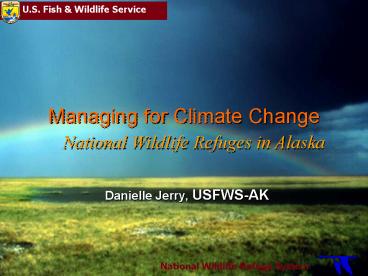Managing for Climate Change - PowerPoint PPT Presentation
1 / 11
Title:
Managing for Climate Change
Description:
(i) Conserve fish and wildlife populations. and habitats in their natural diversity... Traditional wildlife monitoring e.g., waterfowl, moose, ... – PowerPoint PPT presentation
Number of Views:161
Avg rating:3.0/5.0
Title: Managing for Climate Change
1
Managing for Climate Change
National Wildlife Refuges in Alaska
- Danielle Jerry, USFWS-AK
2
- 16 refuges
- Over 76 million acres
- (82 of the Refuge System,
- and 18 of Alaska)
- 18.5 million acres of Wilderness
- in 10 Alaska Refuges
3
ANILCAs 4 Basic Purposes for Alaska Refuges
- (i) Conserve fish and wildlife populations
- and habitats in their natural diversity
(ii) Fulfill the international treaty
obligations ... with respect to fish and wildlife
and their habitats
(iii) Provide consistent with the purposes
(i) and (ii), the opportunity of continued
subsistence uses by local residents
(iv) Ensure water quality and necessary water
quantity within the refuge.
4
Inventory and monitoring of climate effects on
refuges --
- Develop/revise Refuge I M plans emphasis on
ecosystem priorities. - Starting Regional I M plan to set regional
priorities. - Snow depth markers/ Automated weather stations
- Stream flow data collection
- Traditional wildlife monitoring e.g.,
waterfowl, moose, - Kenai Refuge Long Term Ecological Monitoring
Program -- effects of abiotic and biotic factors
on species distribution.
5
Research on climate effects on Refuges
- Alaska Maritime Refuge SE Bering Sea carrying
capacity - Innoko Refuge Studying effects of changing
water levels - on white- fronted geese.
- Koyukuk Refuge Climate change effects on
subsistence - species (UAF-Chapin)
- Kanuti Refuge Fire effects on sensitive plant
- communities (lichens and sage steppe).
- Yukon Flats Refuge Studied changes in water
surface - quality, and invertebrate abundance in
wetlands from - 1984-2003.
6
More management under the Endangered Species Act
as listings in Alaska increase and causes of
decline obscure.
7
As AK species petitioned for listing
growrecovery actions become globally political,
and past successes seem inherently easier.
8
Managing change in fire regimes --
1) Frequency and location lightning strikes in
new areas, season duration 2) Severity drier,
wildland/urban/rural interface expands,
smoke 3) Habitat Effects drier, more
grass, insects, less permafrost
Larger seasonal fire program More fuels
management prevention outreach and agency
coordination Manage for wildland fire
use Research and monitoring
9
Existing regulatory bodies will address the
challenges of climate change on subsistence.
1) Change in abundance and harvest patterns of
fish and wildlife resources. 2) Melting sea
ice-- limits harvest of marine mammals and
increase danger. 3) Disproportionate impact on
subsistence users of changes in salmon
populations.
- Federal Subsistence Management per ANILCA
- Alaska Migratory Bird Co-management
Council. - Marine Mammal Co-Management Commissions
- Endangered Species Act regulations.
- Federal Subsistence Management per ANILCA
- Magnusson/Stevens Act
- State Fisheries management.
10
Water Resources Challenges
- Absence of baseline hydrologic data
- Integrating science, management and law of water
resources to ensure refuge needs are protected - Integrating Federal mandates State law
- Education
- Water is not a renewable resource
- Water rights are property rights
- Functioning Ecosystems are good for wildlife and
the local economy
11
To preserve in their natural state extensive
unaltered arctic tundra, boreal forest, and
coastal rainforest ecosystems
- The ANILCA advantage
- For conservation, geography and size matter































